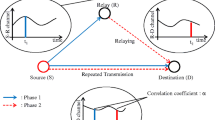Abstract
The previous work on interference alignment for multiple-input-multiple-output (MIMO) two-way X relay channel assumes perfect channel state information at the transmitter (CSIT), which is reasonable in slow fading channel. However, in fast fading scenario, this assumption is impractical. In this paper, assuming that each node has delayed CSIT, we study the achievable degrees of freedom (DOF) for MIMO two-way X relay channel in frequency division duplex (FDD) systems. Specifically, in the broadcast (BC) phase, we propose a new multiple-stage transmission (MST) scheme, which utilizes retrospective interference alignment for physical layer network coding (PLNC). We show that MST can achieve significant DOF gain and tremendous power gain over other schemes. When the number of antennas for each user, N, is smaller than the number of the relays, M, the time division multiple access (TDMA) scheme can only achieve an ergodic sum-rate increase by N bps/Hz for every increasing of 3 dB of signal-to-noise power ratio (SNR), while the proposed MST scheme can achieve an ergodic sum-rate increase by M bps/Hz.
Similar content being viewed by others
References
Hossain E, Rasti M, Tabassum H, et al. Evolution toward 5G multi-tier cellular wireless networks: an interference management perspective. IEEE Wirel Commun, 2014, 21: 118–127
Vander Meulen E. Three-terminal communication channels. Adv Appl Prob, 1974, 3: 120–154
Vander Meulen E. A survey of multi-way channels in information theory: 1961–1976. IEEE Trans Inf Theory, 1977, 23: 1–37
Cover T, Gamal A. Capacity theorems for the relay channel. IEEE Trans Inf Theory, 1979, 25: 572–584
Xing C W, Li S, Fei Z S, et al. How to understand linear minimum-mean-square-error transceiver design for multipleinput multiple-output systems from quadratic matrix programming. IET Commun, 2013, 7: 1231–1242
Xing C W, Ma S D, Fei Z S, et al. General robust linear transceiver design for multi-hop amplify-and-forward MIMO relaying systems. IEEE Trans Signal Proc, 2013, 61: 1196–1209
Jafar S A, Shamai S S. Degrees of freedom region of the MIMO x channel. IEEE Trans Inf Theory, 2008, 54: 151–170
Maddah-Ali M, Motahari A, Khandani A. Communication over MIMO x channels: interference alignment, decomposition, and performance analysis. IEEE Trans Inf Theory, 2008, 54: 3457–3470
Zhang S L, Liew S C, Lam P P. Hot topic: physical-layer network coding. In: Proceedings of the 12th Annual International Conference on Mobile Computing and Networking. New York: ACM, 2006. 358–365
Xiang Z Z, Tao M X, Mo J H, et al. Degrees of freedom for MIMO two-way x relay channel. IEEE Trans Signal Proc, 2013, 61: 1711–1720
Maddah-Ali M, Tse D. Completely stale transmitter channel state information is still very useful. IEEE Trans Inf Theory, 2012, 58: 4418–4431
Maleki H, Jafar S A, Shamai S S. Retrospective interference alignment over interference networks. IEEE J Sel Topic Signal Proc, 2012, 6: 228–240
Abdoli M, Ghasemi A, Khandani A. On the degrees of freedom of K-user SISO interference and x channels with delayed CSIT. IEEE Trans Inf Theory, 2013, 10: 6542–6561
Vaze C, Varanasi M. The degrees of freedom region of the two-user MIMO broadcast channel with delayed CSIT. In: Proceedings of IEEE International Symposium on Information Theory (ISIT), Saint Petersburg, 2011. 199–203
Yi X P, Yang S, Gesbert D, et al. The degrees of freedom region of temporally correlated MIMO networks with delayed CSIT. IEEE Trans Inf Theory, 2014, 60: 494–514
Abdoli M, Ghasemi A, Khandani A. On the degrees of freedom of three-user MIMO broadcast channel with delayed CSIT. In: Proceedings of IEEE International Symposium on Information Theory, Saint Petersburg, 2011. 209–213
Wang I H, Diggavi S. On degrees of freedom of layered two-unicast networks with delayed CSIT. In: Proceedings of IEEE International Symposium on Information Theory, Cambridge, 2012. 46–50
Tandon R, Mohajer S, Poor H, et al. On x channels with feedback and delayed CSI. In: Proceedings of IEEE International Symposium on Information Theory, Cambridge, 2012. 1877–1881
Li Q Y, Li H X, Wu G, et al. Achievable degrees of freedom of MIMO y channel with delayed CSIT. IEEE Commun Lett, 2014, 18: 1583–1586
Li Q Y, Li H X, Wu G, et al. Retrospective network coding alignment over K-user MIMO y channel. IEEE Commun Lett, 2016, 20: 502–505
Author information
Authors and Affiliations
Corresponding author
Rights and permissions
About this article
Cite this article
Li, Q., Wu, G., Li, H. et al. Achievable degrees of freedom of MIMO two-way X relay channel with delayed CSIT. Sci. China Inf. Sci. 59, 082306 (2016). https://doi.org/10.1007/s11432-015-0772-6
Received:
Accepted:
Published:
DOI: https://doi.org/10.1007/s11432-015-0772-6




